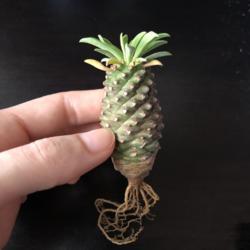
skopjecollection said:Ill give you some universal pointers about euphorbias
-their roots are terrible. I think you can visually see why, but in general: they need coarse draining soil(NOT like echeverias and sedums and other crassulacae). Emphasis on the coarse. This means small gravel, perlite, pumice, crushed brick, baked clay etc... lots of coarse inorganic material to compose the bulk of the soil. Also, extra care during potting. I neednt mention this, but larger holes on the bottom of the pot(and lots of them if you can)...
- they like it moist in winter. They dont have a rest period(like a lot of cacti and succulents), but they do like it dryer in winter, but not completely bone dry as most cacti. Basically half the watering frequency in summer.
-not to bright, not too dark. Euphorbias sun burn easily.
Prefer very bright, but not direct sun, especially suddenly.
Also, dont water for 2 weeks after potting.
Baja_Costero said:Nice plant.
I don't think you can generalize (or universalize) like that about a genus with thousands of species. Euphorbia roots can be really robust. Some Euphorbias react really poorly to winter water. Many Euphorbias do not burn under full sun (there's plenty of them here that get nearly day-long sun with no ill consequences).
The plant in the original post looks good to me. Be careful not to put it in too big a pot. Maybe 4" to start with, wider than deep, with fast draining soil. It may lose some or all its leaves from the stress of being bare rooted and moved to a new home, but that should be entirely reversible once it gets started again. Find a place with lots of light if the plant will be indoors (try to max out the light and place the plant close to a very sunny window) but if it will be outdoors, it will require protection from overhead sun (bright shade or filtered light would be best outdoors, at least for starters).
Wait a week after potting up the plant to water deeply for the first time.
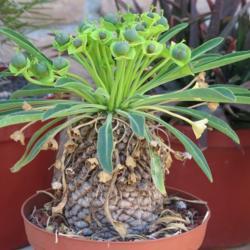
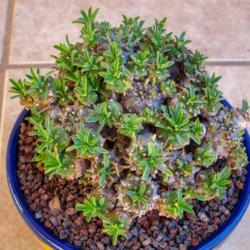

Baja_Costero said:E. lactea, ingens, trigona (all tree-like plants when mature), resinifera, milii, and several medusas tolerate full sun here without any problem. The trees tolerate day-long sun with no problem (as one would expect from their habit).
Baja_Costero said:I am still scratching my head at why or how a tree Euphorbia could be sensitive to sunburn, except perhaps in the presence of extreme heat. I would recommend you adjust how you accommodate succulents to the sun to give them more time and more of a gradual progression.
skopjecollection said:I think you would do fine with pumice and turface with a bit of soil mixed in(a bit, like 30-20%). What is crushed grit? Is it fine, is coarse? Is it like sharp gravel? If the later, coarse and sharp, definitely. Unless its made from mostly limestone...then no,...or if its fine and very dusty/sandy...also no.
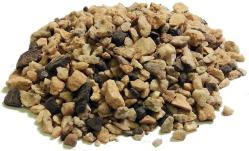 and no limestone as far as what was advertised.
and no limestone as far as what was advertised. Baja_Costero said:Take a look at these pictures of Euphorbia bupleurifolia and hybrids for more examples of pineapple-looking plants. I am partial to the leafy tuberculate Euphorbias myself.
- Euphorbia (Euphorbia bupleurifolia)
- Uploaded by Baja_Costero
- Euphorbia 'Cocklebur'
- Uploaded by Baja_Costero
- Euphorbias (Euphorbia)
- Uploaded by Baja_Costero
The mix which I use is 50% pumice, 50% organic (half cocofiber, half compost). You should be able to make an all-inorganic mix work if you increase the watering accordingly.
Was the plant really buried up to the brown line before? Maybe it was seated right in the soil and there was top dressing (coarse rock on top of the soil) up to the line? I would put it up so the minimum amount of actual stem is buried. You can use top dressing to help keep it upright if you need to.
I don't think there is any advantage to waiting more than a week to water.
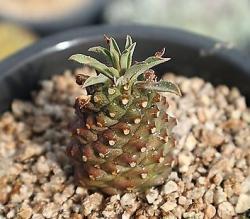
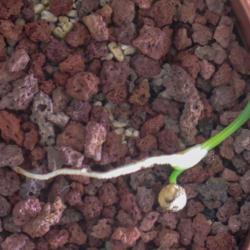
Baja_Costero said:OK, a quick lesson in names. The species name hypogaea means "below the soil" and that combination can be found in terms like "hypogeal germination" which would apply to the species below, which germinates below the soil and sends shoots both upward and downward from there. An uprooted seedling showing hypogeal germination:
- Mexican Boulder (Beaucarnea hookeri)
- Uploaded by Baja_Costero
Not the best picture but I think you get the point. Gaea was the Greek goddess of the earth.
I have no experience with this species but I looked it up the Euphorbia Journal and here's what I learned. Thank you for the inspiration to look this plant up, it was interesting to read about.
The "almost entirely subterranean caudex" branches underground and apparently only the branches, not the main stem, are typically visible in habitat. Apparently underground growth is an advantage for this species because of the harsh, hot climate where it lives. They say the plant is difficult to maintain in cultivation because of this underground habit (which is rot-prone with excess moisture), and it is typically lifted in cultivation, both to display the stem and to avoid rot issues. You will want to use a mix that is more than 50% inorganic. The grit you have shown should work, maybe with a small amount of organic (like 10% cocofiber) mixed in.
Further advice from the Euphorbia Journal (which I do recommend by the way): extremely rare in collections; not recommended for beginners. Apparently this plant almost inevitably has a short lifespan in cultivation. I have never seen one in real life.
I would try to lift the stem some from where it was before. Maybe not all the way, maybe just below where your thumb is in the picture. Be aware that recently raised stem is extra sensitive to sunburn so you will want to avoid any exposure to direct outdoor sun for the first few months. Normally I would say keep a succulent at the same depth it was previously when you repot, but this is sort of a special case and raising it is specifically proposed as a helpful measure in the book.
It will be important for you to make sure the soil goes dry before watering, and avoid overwatering during winter. This plant is from near the cape in South Africa and it gets some or most of its rain during winter, so I don't think you should keep it completely dry during that period. If you can make sure the soil is dry at depth when you water, you should be okay.
E. bupleurifolia grows to about 10 inches tall and will be content in a 6 inch pot for life (15-20 years). It has been a very easy plant for me to keep and repdroduce, but you do have to make sure you provide good drainage, don't overwater, and are especially careful to allow the soil to go dry before repotting (and allow it to stay dry for a week afterward).
E. x japonica (aka "Cocklebur" = bupleurifolia x susannae) will grow to about 8-10 inches wide given enough time but it requires a shallower pot because its roots are insubstantial. It is very easy to restart from cuttings should you run out of space down the road. The other parent of this hybrid (susannae) is also an attractive plant. Mine is reaching 11-12 inches (many dozens of heads) but it's pretty old at this point.
These 3 plants should be relatively available, and orders of magnitude more common than E. hypogaea.
Baja_Costero said:Can you ask the grower for advice?
sech said:Hi all,
Just got this Euphorbia Hypogaea three days ago.
I've never had one before so I'd like to know how to care for it and make sure it's happy and healthy. My experience is mostly limited to Echeverias and other stonecrop plants.
Also, I've noticed it's been losing a few leaves to wilting/yellowing. Should I be worried?
Thanks in advance.
- Euphorbia (Euphorbia hypogaea)
- Uploaded by sech